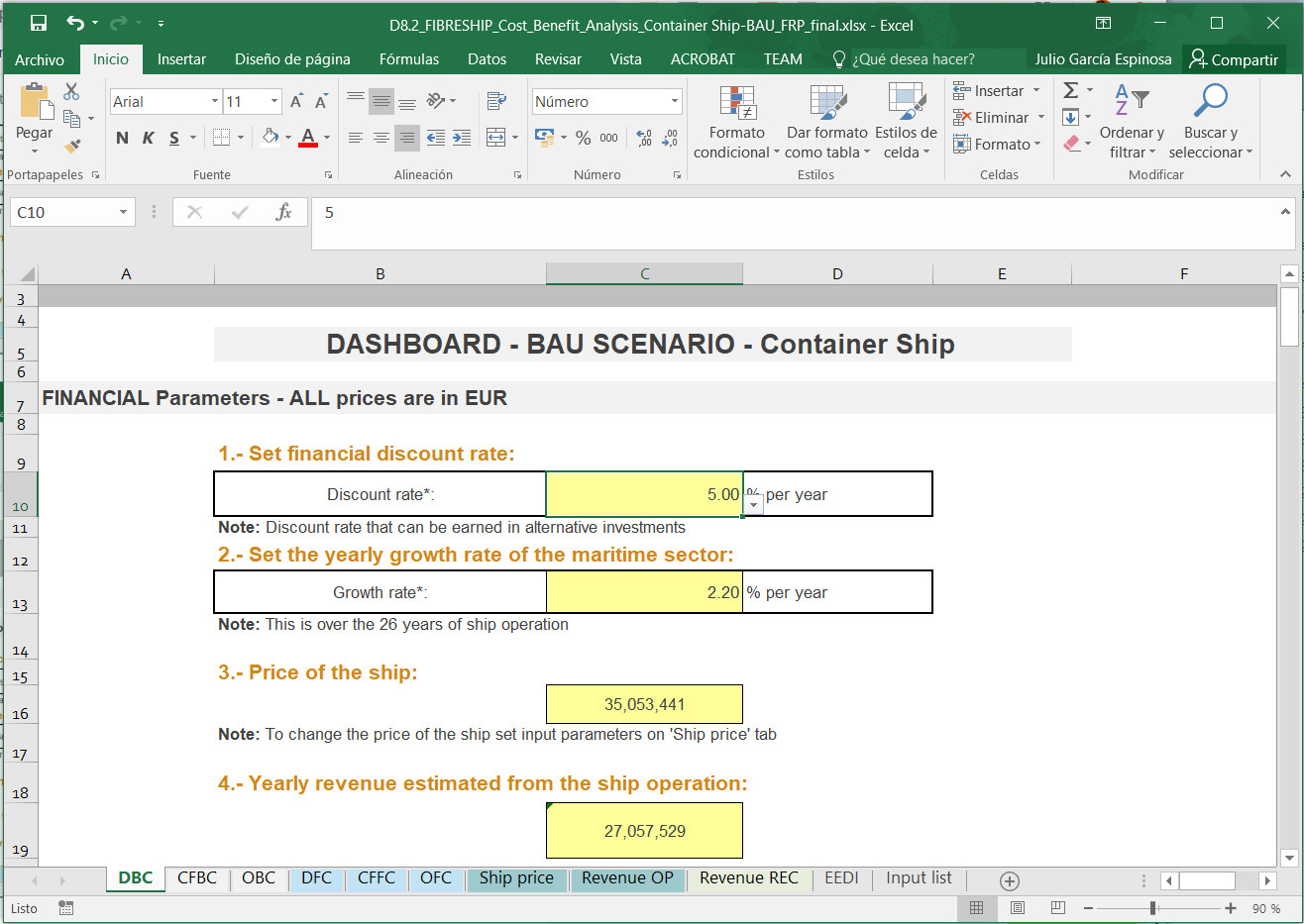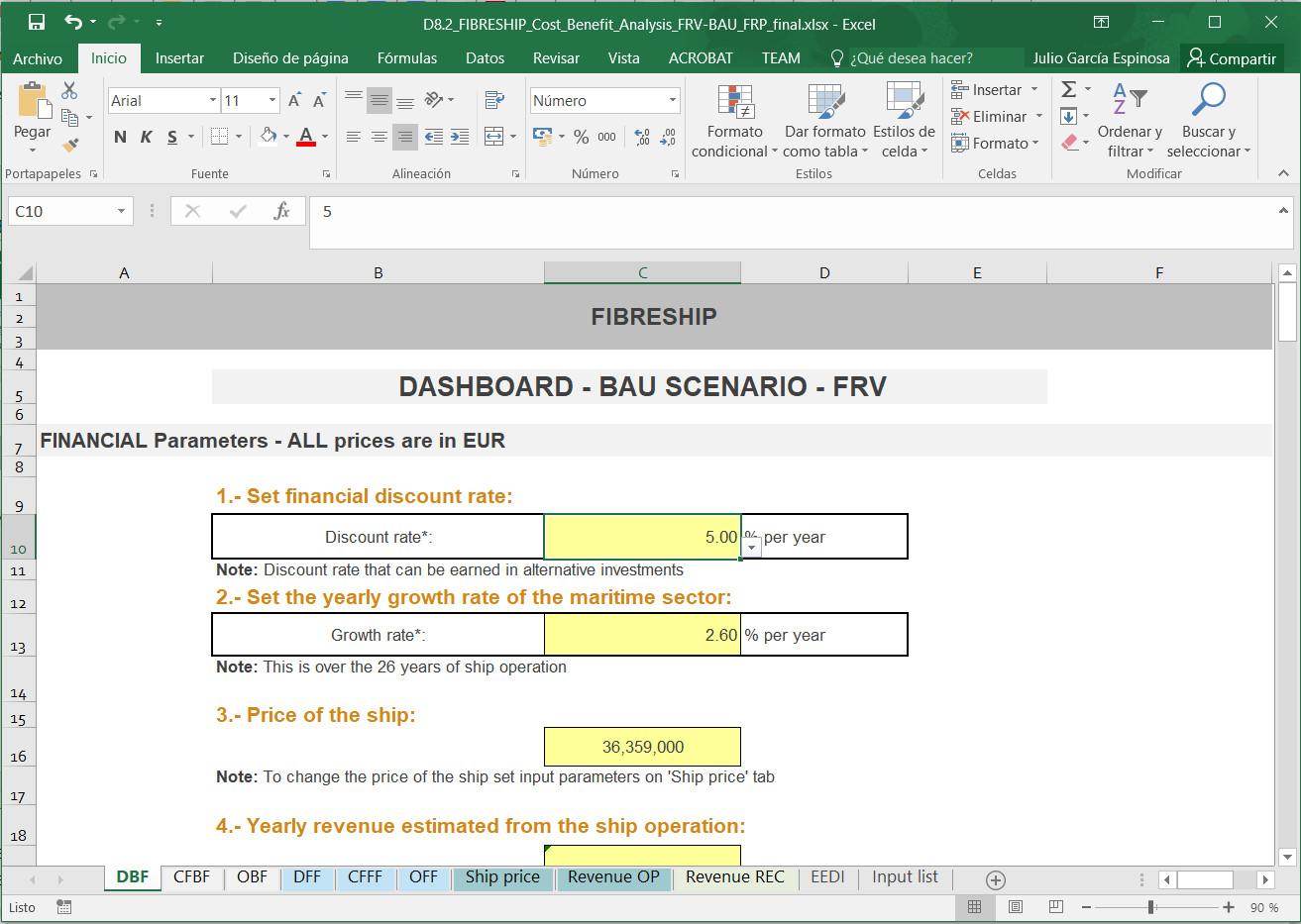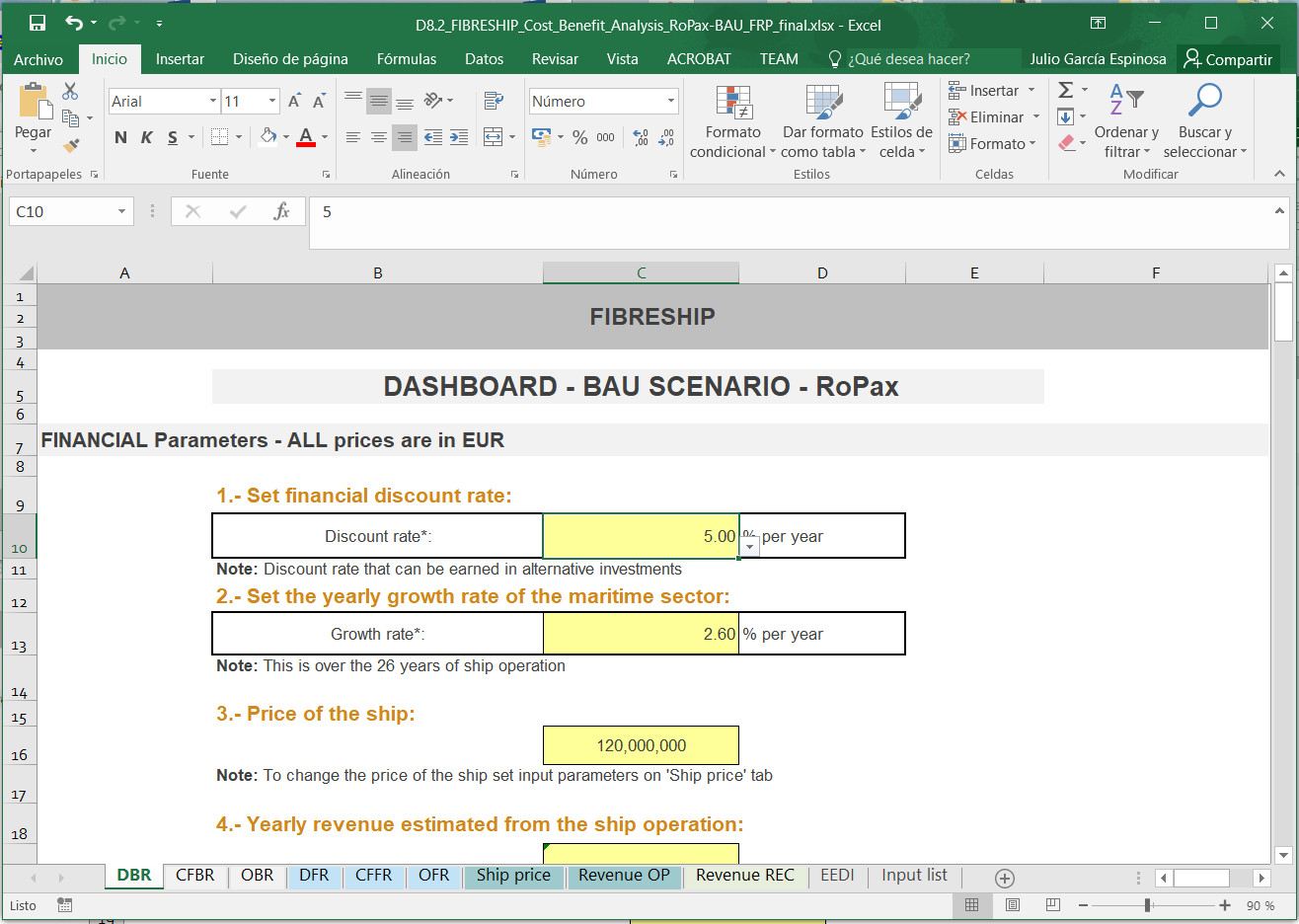| (3 intermediate revisions by the same user not shown) | |||
| Line 6: | Line 6: | ||
<big>'''Engineering, production and life-cycle management for the complete construction of large-length FIBRE-based SHIPs'''</big></div> | <big>'''Engineering, production and life-cycle management for the complete construction of large-length FIBRE-based SHIPs'''</big></div> | ||
| − | |||
| + | == SUMMARY== | ||
| − | + | This document is related to the report D8.2 of the workpackage 8 of the Fibreship project. The main goal of this workpackage was to provide cost benefit analysis support throughout to entire project in the technical work packages related to the analysis of large-length fibre-based commercial vessels (FRP) such as the three types targeted in the project: container ship, Ro-Pax, and Fishing Research Vessel (FRV) and to benchmark them with conventional steel (BAU) vessels. Technical decision support with cost-benefit analysis included production, operation and dismantling of the above mentioned vessels of the same size by using NPV, RRI and ROI calculations, with the reflection of operational costs in fuel saving due to weight reduction. The deliverable reflects to the needs of industry stakeholders by revealing cost-benefit information and concludes with the financial comparison between conventional (steel) and FRP vessels. | |
| − | The | + | The experience acquired throughout the project has been implemented in different cost-benefit analysis tools for the targeted vessels. These tools can be found below. |
| − | + | ||
| − | + | ||
| − | + | ||
| − | + | ||
| − | + | ||
| − | + | ||
| − | + | ||
| − | + | ||
| − | + | ||
| − | + | ||
| − | + | ||
| − | + | ||
| − | + | ||
| − | + | ||
| − | + | ||
| − | + | ||
| − | + | ||
| − | + | ||
| − | + | ||
| − | + | ||
| − | + | ||
| − | + | ||
| − | + | ||
| − | + | ||
| − | + | ||
| − | + | ||
| − | + | ||
| − | + | ||
| − | + | ||
| − | + | ||
| − | + | ||
| − | + | ||
| − | + | ||
| − | + | ||
| − | + | ||
| − | + | ||
| − | + | ||
| − | + | ||
| − | + | ||
| − | + | ||
| − | + | ||
| − | + | ||
| − | + | ||
| − | + | ||
| − | + | ||
| − | + | ||
| − | + | ||
| − | + | ||
| − | + | ||
| − | + | ||
| − | + | ||
| − | + | ||
| − | + | ||
| − | + | ||
| − | + | ||
| − | + | ||
| − | + | ||
| − | + | ||
| − | + | ||
| − | + | ||
| − | + | ||
| − | + | ||
| − | + | ||
| − | + | ||
| − | + | ||
| − | + | ||
| + | <!-- | ||
==NOMENCLATURE/ ACRONYM LIST== | ==NOMENCLATURE/ ACRONYM LIST== | ||
| Line 204: | Line 139: | ||
<span id='_Toc37404352'></span><span id='_Toc42092943'></span> | <span id='_Toc37404352'></span><span id='_Toc42092943'></span> | ||
| − | ==1. | + | ==1. INTRODUCTION== |
The implementation of the cost-benefit analysis idea was brought up by the time of the FiBRESHiP proposal preparation when it was decided to include an additional task in WP8 to provide the necessary background calculations for technical work package and task leaders. Our intention was to give rapid feedbacks with economic calculations about the development of joining techniques, material selection, fire safety and recycling. The reason behind this regime was to keep development costs in bay and make warnings if a specific technology development task in FiBRESHiP would bring the solution to an unattainable market price. | The implementation of the cost-benefit analysis idea was brought up by the time of the FiBRESHiP proposal preparation when it was decided to include an additional task in WP8 to provide the necessary background calculations for technical work package and task leaders. Our intention was to give rapid feedbacks with economic calculations about the development of joining techniques, material selection, fire safety and recycling. The reason behind this regime was to keep development costs in bay and make warnings if a specific technology development task in FiBRESHiP would bring the solution to an unattainable market price. | ||
| Line 215: | Line 150: | ||
<span id='_Toc42092944'></span> | <span id='_Toc42092944'></span> | ||
| + | |||
==2. OVERVIEW OF THE FIBRESHIP SOLUTION== | ==2. OVERVIEW OF THE FIBRESHIP SOLUTION== | ||
| Line 517: | Line 453: | ||
<br/> | <br/> | ||
| + | --> | ||
| + | |||
| + | ==COST-BENEFIT ANALYSIS TOOLS== | ||
| + | |||
| + | |||
| + | [[Image:Garcia-Espinosa_2020a_3844_Container Ship Tool.jpg|link=https://www.scipedia.com/wd/images/5/51/Garcia-Espinosa_2020a_6123_D8.2_FIBRESHIP_Cost_Benefit_Analysis_Container_Ship-BAU_FRP_final.xlsx|D8.2 Cost Benefit Analysis Tool of the Container Ship]] | ||
| + | |||
| + | |||
| + | [[Image:Garcia-Espinosa_2020a_2434_BAU.jpg|link=https://www.scipedia.com/wd/images/a/a7/Garcia-Espinosa_2020a_8819_D8.2_FIBRESHIP_Cost_Benefit_Analysis_FRV-BAU_FRP_final.xlsx|D8.2 Cost Benefit Analysis Tool of the Fishing Research Vessel]] | ||
| + | |||
| − | = | + | [[Image:Garcia-Espinosa_2020a_9240_RoPax.jpg|link=https://www.scipedia.com/wd/images/e/e1/Garcia-Espinosa_2020a_4050_D8.2_FIBRESHIP_Cost_Benefit_Analysis_RoPax-BAU_FRP_final.xlsx|D8.2 Cost Benefit Analysis Tool of the RoPax Vessel]] |
Latest revision as of 19:03, 3 June 2020
SUMMARY
This document is related to the report D8.2 of the workpackage 8 of the Fibreship project. The main goal of this workpackage was to provide cost benefit analysis support throughout to entire project in the technical work packages related to the analysis of large-length fibre-based commercial vessels (FRP) such as the three types targeted in the project: container ship, Ro-Pax, and Fishing Research Vessel (FRV) and to benchmark them with conventional steel (BAU) vessels. Technical decision support with cost-benefit analysis included production, operation and dismantling of the above mentioned vessels of the same size by using NPV, RRI and ROI calculations, with the reflection of operational costs in fuel saving due to weight reduction. The deliverable reflects to the needs of industry stakeholders by revealing cost-benefit information and concludes with the financial comparison between conventional (steel) and FRP vessels.
The experience acquired throughout the project has been implemented in different cost-benefit analysis tools for the targeted vessels. These tools can be found below.
COST-BENEFIT ANALYSIS TOOLS
Document information
Published on 03/06/20
Licence: CC BY-NC-SA license
Share this document
Keywords
claim authorship
Are you one of the authors of this document?



